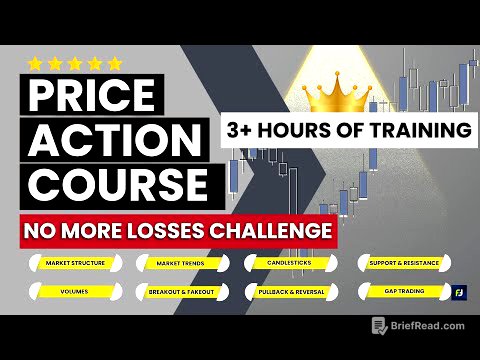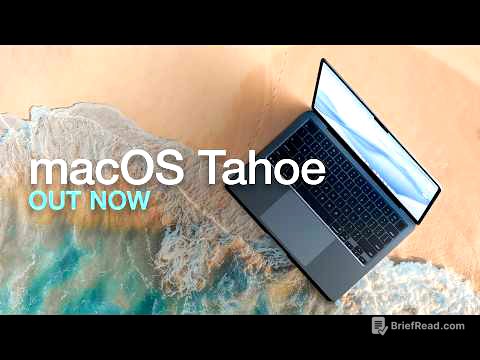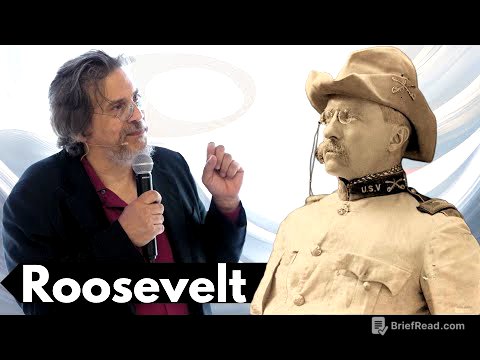TLDR;
This video discusses common financial reasons why new businesses fail. The key takeaways are:
- Insufficient Capital: Starting a business without enough capital can lead to early demise.
- Poor Cash Management: Tracking cash inflows and outflows is crucial for paying bills and ensuring the business's well-being.
- Poor Record Keeping and Controls: Accurate record-keeping and internal controls are essential for running a business effectively, obtaining financing, and managing tax obligations.
- Improper Product Pricing: Pricing a product too high can lead to underpricing by competitors, while not covering all costs can make the business unsustainable.
- Uncontrolled Growth: Rapid growth can lead to cash flow problems, especially for new businesses with limited capital.
Introduction [0:00]
This video focuses on the financial reasons for business failure. It highlights five common reasons: insufficient capital, poor cash management, poor record keeping and controls, improper product pricing, and uncontrolled growth. The video emphasizes that these reasons are often interrelated and will be addressed separately.
Business Finance [0:05]
The video starts by discussing the importance of having sufficient capital to start a business. It emphasizes that many new businesses fail because they lack the financial resources to support their operations while their cash flows get up to speed. The video stresses the importance of budgeting cash inflows and outflows to determine any potential cash shortages and make necessary arrangements for financing.
Insufficient Capital [2:09]
This section delves into the issue of insufficient capital. It explains that many new businesses start without enough money in the bank to cover their expenses while they wait for customers to find them and pay. The video highlights the importance of having access to sufficient capital to allow the business enough time to succeed. It also emphasizes the need for a cash forecast to determine how much capital is needed to get through the critical first few months.
Cash Flows [5:41]
This chapter focuses on cash management. It distinguishes between fixed costs, which are constant, and variable costs, which vary based on activity or a cost driver. The video emphasizes the importance of identifying all fixed and variable costs to create an accurate cash forecast. It also discusses the importance of forecasting customer demand, as this will significantly impact variable costs.
Customers [7:26]
This section emphasizes the importance of accurately forecasting customer demand. It explains that a business's success or failure depends on the number of customers it can realistically expect. The video suggests various methods for forecasting customer demand, including competitor analysis, population growth assessment, and customer surveys.
Recordkeeping [8:35]
This chapter highlights the importance of proper record-keeping and internal controls. It compares record-keeping to tracking statistics in a football game, emphasizing that while it may not be glamorous, it is essential for effective business management. The video outlines three key reasons for accurate record-keeping: better business information, obtaining external financing, and managing tax obligations.
Controls [11:11]
This section focuses on internal controls. It defines controls as procedures that ensure the accuracy and reliability of information collected in the accounting system and safeguard assets and records. The video discusses various control measures, including documentation of cash outflows, inventory tracking, employee pay rate and Social Security number protection, and customer list and pricing information security. It also emphasizes the importance of safeguarding cash and implementing procedures for quick and correct deposits and authorized expenditures.
Product Pricing [14:04]
This chapter discusses product pricing. It emphasizes that simply adding a markup to costs is not enough. The video explains that businesses often have to be price takers, meaning they must manage their costs to earn a profit given a market-determined price. The biggest mistake new business owners make is not considering and covering all their costs. While a temporary loss-leader strategy might be used to gain market share, it is not sustainable over the long term.
Managing Growth [15:09]
This section focuses on the dangers of uncontrolled growth. It explains that while growth is desirable, it can be fatal to a business if not managed carefully. The video highlights that growth often requires cash, which is often in short supply for new businesses. It emphasizes that fast growth can exacerbate cash flow problems and that businesses should focus on managing growth rather than simply accelerating it.
Budgeting [16:46]
This chapter introduces the concept of budgeting. It explains that a budget is a plan that allows for monitoring performance in relation to goals. The video outlines the two-fold purpose of budgeting: developing a plan to meet a specified goal and comparing actual results to the plan. It emphasizes the importance of budgeting for both individuals and organizations, highlighting the severe consequences of not budgeting.
Behavioral Considerations [20:25]
This section discusses behavioral considerations in the budgeting process. It emphasizes the importance of top management support, employee involvement, and constructive feedback on budget deviations. The video highlights the negative consequences of using the budget as a punishment tool, such as loss of motivation, dysfunctional behavior, and budgetary slack.
Involving People [23:17]
This chapter explores different approaches to budgeting. It contrasts the top-down approach, where top management prepares the budget and distributes it to lower levels, with the bottom-up approach, where individual managers prepare budget requests that are then combined and reviewed. The video argues that both approaches have their merits and that most organizations use a combination of the two. It emphasizes the importance of involving lower-level managers in the budgeting process to ensure their motivation and develop their planning skills.
Master Budget [26:50]
This section introduces the master budget, which is an integrated group of detailed budgets that constitute the overall operating, investing, and financing plans for a specific period. The video explains that the master budget begins with a sales forecast, which then drives the capital budget, production budget, and selling and administrative expense budget. It also mentions the cash budget and pro forma financial statements, which are discussed later in the video.
Sales Budget [30:53]
This chapter focuses on the sales budget, which is the most important component of the master budget. It explains that the sales budget is the starting point for the budgeting process and drives many other related budgets. The video discusses the difficulty of accurately projecting sales, as they are influenced by both uncontrollable external factors (customer tastes, economic conditions) and controllable internal factors (price, sales effort, advertising). It also outlines various external factors that impact sales, such as the business environment, customer needs and tastes, competition, seasonal cycles, and unexpected events.
Production Budget [33:22]
This section discusses the production budget, which covers the number of units to be produced during a period. It explains that the production budget is based on projected sales volume, desired ending inventory, and beginning inventory. The video emphasizes the importance of maintaining sufficient inventory to meet customer demand without incurring excessive costs.
Direct Materials Budget [34:21]
This chapter focuses on the direct materials budget, which helps management schedule purchases from suppliers. It explains that the materials purchases budget is based on the level of production and required ending inventories. The video highlights the importance of maintaining sufficient materials to avoid production delays and excessive inventory investment and storage costs.
Direct Labor Budget [35:09]
This section discusses the direct labor budget, which outlines the labor costs for production. It explains that the budget includes wages, fringe benefits, and payroll taxes. The video emphasizes the importance of planning for sufficient labor availability to avoid the high costs of frequent hiring, firing, layoffs, and overtime work. It also highlights the negative impact of job insecurity on employee morale.
Manufacturing Overhead Budget [36:33]
This chapter focuses on the manufacturing overhead budget, which includes all production costs other than direct materials and direct labor. It explains that effectively planning and controlling manufacturing overhead costs can provide a significant advantage in the marketplace. The video outlines the steps involved in preparing a manufacturing overhead budget, including estimating annual variable and fixed overhead costs and allocating variable overhead costs based on direct labor hours.
Selling, General, and Administrative Budget [37:24]
This section discusses the selling, general, and administrative budget, which covers planned expenditures for all areas other than production. It explains that this budget includes costs such as supplies, salaries, and depreciation of administrative assets. The video highlights that this budget is often complex and may be supported by individual budgets for specific departments within the selling and administrative functions.
Merchandising, Retail and Wholesale [40:05]
This chapter discusses the budgeting process for merchandising companies, which buy products rather than make them. It explains that the budgeting process for merchandising companies is less complicated than that for manufacturing companies. The video highlights that merchandising companies replace the production, direct materials, direct labor, and manufacturing overhead budgets with a single purchases budget.
Services [42:29]
This section discusses the budgeting process for service companies, which provide services to customers instead of products. It explains that the budgeting process for service companies is similar to that for manufacturing companies, with a focus on labor and overhead costs. The video highlights that service companies do not require a production budget because they sell intangible products that cannot be inventoried.
Cash Budget [44:18]
This chapter focuses on the cash budget, which shows expected cash receipts and disbursements during a period. It explains that the cash budget is impacted by all preceding budgets in the master budget. The video highlights that a detailed cash budget can identify when a company has excess cash to invest and when it needs to borrow funds. It also discusses the importance of managing accounts receivable collections, as this is a major source of cash.
Flexible [45:47]
This section discusses flexible budgets, which are more useful for control and performance evaluation than static budgets. It explains that flexible budgets are dynamic and can be tailored to any level of activity within a relevant range. The video highlights that flexible budgets allow managers to determine what costs should have been for the actual level of activity attained.
Operating Cash-Flow [47:02]
This chapter focuses on the operating cash flow cycle, which is the time it takes for a company to convert purchased raw materials into operating cash collections. It explains that the operating cycle is the sum of the number of days sales and inventory and the average collection period. The video uses Nike as an example to illustrate the operating cash flow cycle and how companies must manage purchases, sales, and cash collections to balance the timing of cash payments and collections.
Investing Cash-Flow [52:30]
This section discusses investing cash flows, which are related to the purchase of long-term operating assets such as land, buildings, and equipment. It explains that these purchases are classified as investing activities in the statement of cash flows. The video highlights that the value of long-term operating assets stems from their ability to generate future cash flows. It also introduces the concept of capital budgeting, which is the process of making decisions about acquiring long-term operating assets.
Financing Cash-Flow [57:31]
This chapter focuses on financing cash flows, which are related to borrowing and owner investment. It explains that the most desirable sequence of decision-making with respect to financing cash flows involves forecasting activity levels, evaluating cash generated or consumed by operating activities, determining cash needed for investing activities, and comparing the costs of borrowing and owner investment. The video highlights that the cost of borrowing is generally lower than the cost of giving up ownership.
Revenue Recognition Phase 1 [59:41]
This section introduces the concept of revenue recognition. It explains that there are two traditional revenue recognition criteria that must be satisfied before revenue can be recognized: the seller must complete the work, and the buyer must pay or provide a valid promise to pay. The video uses Cash and Carry businesses, such as Walmart, as an example to illustrate how these criteria are applied in simple transactions.
Revenue Recognition Phase 2 [1:02:23]
This chapter continues the discussion on revenue recognition. It explains that revenue can be recognized before cash is collected if the buyer has provided a valid promise to pay. The video uses credit sales as an example and discusses the costs associated with selling on credit, including bad debts, bookkeeping costs, and carrying costs. It also highlights why companies like Boeing sell on credit while companies like McDonald's do not.
Revenue Recognition Phase 3 [1:07:52]
This section concludes the discussion on revenue recognition. It explains that revenue cannot be recognized after cash is collected but before the work is done. The video uses airline tickets and gift cards as examples to illustrate this point. It highlights that companies like United Airlines must record an obligation to provide a service for which they have already collected cash. The video also discusses how companies like Walmart recognize revenue for unredeemed gift cards based on historical redemption rates.









